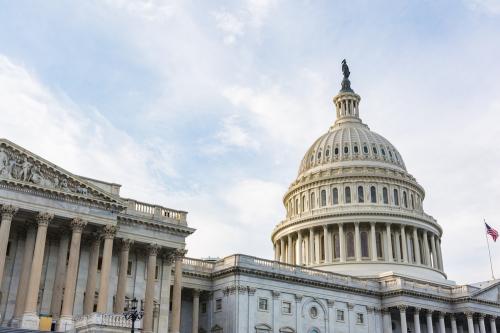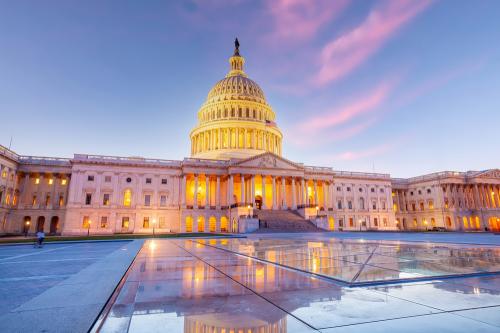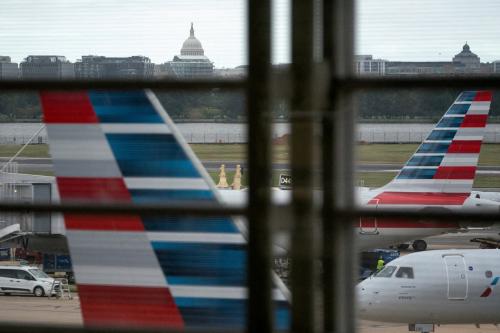This piece was originally published in July 2023. It has since been updated to reflect ongoing developments.
Congress failed to fund the government before the fiscal year ended on September 30, 2025, triggering the first government shutdown since 2019. The shutdown lasted 43 days—the longest in history—and finally ended on November 12. Congress passed, and President Trump signed, three appropriations bills for the full fiscal year—the ones funding agriculture, military construction and veterans, and Congress itself—and funded the rest of the government through January 30, 2026.
Why do government shutdowns happen?
Under the Antideficiency Act (initially passed in 1884 and amended in 1950), federal agencies cannot spend or obligate any money without an appropriation (or other approval) from Congress. When Congress fails to enact the 12 annual appropriation bills, federal agencies must cease all non-essential functions until Congress acts. This is known as a government shutdown. If Congress enacts some but not all of the 12 appropriations bills, only agencies without appropriations have to shut down; this is known as a partial shutdown.
What happens when a shutdown occurs?
During shutdowns, many federal employees are told not to report for work, though under a 2019 law they get paid retroactively when the shutdown ends. Government employees who provide what are deemed essential services, such as air traffic control and law enforcement, continue to work, but don’t get paid until Congress takes action to end the shutdown. All this applies only to the roughly 25% of federal spending subject to annual appropriation by Congress.
Benefits such as Social Security and Medicare continue to flow because they are authorized by Congress in laws that do not need annual approval (although the services offered by Social Security benefit offices may be limited during a shutdown). In addition, the Treasury can continue to pay interest on U.S. Treasury debt on time.
Shutdowns can be disruptive, leading to delays in processing applications for passports, small business loans, or government benefits; shuttered visitor centers and bathrooms at national parks; fewer food-safety inspections; and other various inconveniences.
Several agencies posted contingency plans, with details, in advance of the fall 2025 shutdown. The Labor Department, for instance, in a plan dated September 26, 2025, said that about 3,100 of its roughly 12,900 employers would remain on the job in the event of a shutdown. Only one—the acting commissioner—of the approximately 2,000 employees at the Bureau of Labor Statistics would be working, and so scheduled releases of economic data were delayed during the 2025 shutdown. In its plan, the Justice Department said 90% of its employees would be exempted from the furlough; about 102,300 of its around 115,100 employees would remain on the job, including all FBI employees and 85% of the Drug Enforcement Administration staff. The Department of Homeland Security said in its 76-page contingency plan that roughly 95% of its nearly 272,000 employees would remain on the job if a shutdown occurred because their work is financed outside of the appropriations process (including fees), is necessary to perform activities expressly authorized or implied by law, is necessary to the discharge of the President’s constitutional powers, or is necessary to protect life and property. The Defense Department said around 406,000 of its roughly 741,500 civilian employees would keep working even if Congress failed to act before October 1.
In early November, the New York Times estimated that 700,000 federal employees were working without pay. Uniformed military remained on the job, and the Trump administration found a way to pay them during the October 2025 shutdown.
In a September 2025 message to agencies, Trump White House budget director Russell Vought said that if Congress failed to act before September 30— and it did fail to act—agencies were “directed to use this opportunity to consider Reduction in Force (RIF) notices for all employees in programs, projects, or activities (PPAs) that satisfy all three of the following conditions: (1) discretionary funding lapses on October 1, 2025; (2) another source of funding, such as H.R. 1 (Public Law 119-21) is not currently available; and (3) the PPA is not consistent with the President’s priorities.” But the funding bill that Congress passed in November 2025 included a provision to undo any Reductions in Force issued during the shutdown.
What about the courts and Congress?
In a 1981 opinion, Attorney General Benjamin Civiletti said that the president could continue to exercise his constitutional responsibilities during a shutdown. With that logic, lawyers for the federal courts and Congress have said that judges and members of Congress—and those who support them in their essential duties—can stay on the job even if the appropriations bills that fund them lapse. But some judicial and congressional employees are furloughed.
In a shutdown, according to the Administrative Office of the U.S. Courts, federal courts continue to operate for a while by drawing on fees they have collected (as distinguished from appropriations) and by delaying new hires, non-case related travel, etc. If the shutdown is prolonged and those funds are spent, then the courts say they can continue work that supports their constitutional powers.
As for Congress, the Congressional Research Service says, “Due to their constitutional responsibilities and a permanent appropriation for congressional pay, members of Congress are not subject to furlough.” Only those congressional staffers whose work is “required to support Congress with its constitutional responsibilities or those necessary to protect life and property” can remain on the job. But even those congressional staff don’t get paid during a shutdown, though they do get paid retroactively.
How does a continuing resolution work?
When Congress hasn’t passed appropriations bills for an entire fiscal year, it sometimes passes temporary spending bills—continuing resolutions—that fund government operations until a specified date. Continuing resolutions often, although not always, continue the level of funding at the prior year’s appropriations level. According to the Government Accountability Office, there were 47 continuing resolutions (often known as “CRs” inside the Beltway) between fiscal years 2010 and 2022. They ranged in duration from one day to just under six months. Although they keep the government operating, the GAO said they can be difficult for government agencies to manage, because they often have to plan for a government shutdown because they can’t be sure a CR will pass, they can disrupt agency hiring plans, and they make planning difficult.
How common are government shutdowns?
There have been five shutdowns where operations were affected for more than one business day. In 1995-1996, President Clinton and the Republican Congress were unable to agree on spending levels; the government shut down twice, for a total of 26 days. In 2013, a standoff over funding for the Affordable Care Act resulted in a 16-day shutdown. In December 2018 and January 2019, a dispute over border wall funding led to a shutdown that lasted 35 days; it was a partial shutdown because Congress had previously passed five of the 12 appropriation bills. And the 2025 shutdown lasted 43 days, ending on November 12.
What impact do government shutdowns have on the overall economy?
A shutdown of a few days is a hassle—and undermines public confidence in the capacity of U.S. politicians to do the people’s business—but is unlikely to have a significant impact on the economy. A prolonged shutdown, however, can cause bigger problems, albeit most temporary.
Based on past shutdowns—and the fall 2025 shutdown could be different—Goldman Sachs estimates in a report to clients that the direct effect of federal furloughs would be to reduce the annualized growth rate of real GDP by 0.15 percentage point in the fourth quarter of 2025 with an equally sized bounce back in GDP in the first quarter of 2026. The negative effect of a decline in purchases of goods and services by the federal government, Goldman Sachs says, “should be minimal in a short shutdown but could subtract from growth in the event of a prolonged shutdown.”
JPMorgan economist Michael Feroli estimates that reduced government activity in each week of a shutdown shaves 0.1 percentage point off annualized GDP growth. “Looking at jobs,” he said, “the shutdown affects a fairly small part of the government and many furloughed employees will receive back pay. However, the impact could be worse this time due to the threatened layoffs and actual job loss, which could create risks for the labor market and consumer spending.”
The Congressional Budget Office estimated that the five-week partial shutdown in late 2018 and early 2019—partial because five of the 12 appropriation bills had been passed—reduced the level of GDP growth by 0.1% in the fourth quarter of 2018 ($3 billion in 2019 dollars) and by 0.2% in the first quarter of 2019 ($8 billion), mainly from the loss of furloughed federal workers’ pay and the delay in federal spending on goods and services. “Although most of the real GDP lost … will eventually be recovered, CBO estimates that about $3 billion will not be,” CBO said. In other words, the GDP in 2019 was estimated to be 0.02% lower because of the shutdown than it otherwise would have been. The CBO estimates did not account for such indirect effects as the inability of some businesses to obtain federal permits or apply for federal loans.
In an October 29, 2025 letter to Congress, CBO said that the shutdown “will have negative effects on the economy, although many of those effects will be temporary.” It estimated that a six-week shutdown (about how long the fall 2025 shutdown lasted) would reduce GDP growth in the fourth quarter by 1.5 percentage points at an annual rate, but boost growth by 2.2 percentage points in the first quarter of 2026, and shave a bit off of growth in the following three quarters. The cumulative effect of a six-week shutdown by the end of 2026 would be to reduce real GDP (in 2025 dollars) by $11 billion, a very small effect in a $30 trillion economy, CBO said.
-
Acknowledgements and disclosures
The Brookings Institution is financed through the support of a diverse array of foundations, corporations, governments, individuals, as well as an endowment. A list of donors can be found in our annual reports published online here. The findings, interpretations, and conclusions in this report are solely those of its author(s) and are not influenced by any donation.
The Brookings Institution is committed to quality, independence, and impact.
We are supported by a diverse array of funders. In line with our values and policies, each Brookings publication represents the sole views of its author(s).







Commentary
What is a government shutdown?
November 14, 2025